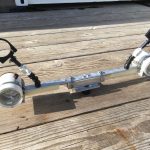Mission Day: One, Two and Three
It has been whirlwind since I arrived in Bermuda on Tuesday at 3pm. Arriving at the Baseline Explorer I had a “todo” list an arm’s length; that list kept going. Working until 11pm on Tuesday we finally got to our accommodations and were up first thing Wednesday morning for another day of lists; ending that day also at 11pm.
Divers Todd Kincaid, Susan Bird and myself preparing for entry of our dive support boat, Fountain – a 39’ ChrisCraft. The other dive team was already in the water.

Working on aligning the cameras in the SVS underwater video system. Note that there are two cameras mounted on either end, slightly off angle. When the videos from both cameras are placed into a computer software program, it creates a 3D video that the scientists can use to study fish density and bottom density, coral configuration; basically the quality of the underwater environment. This can then be used as a “baseline” for future evaluation of the Bermuda Rise; thus, Project “Baseline”.


 Next Post
Next Post